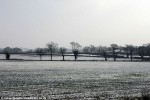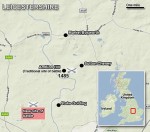 Archaeologists confirmed yesterday that they have not only found the place where the forces of Lancaster and York made their last stand at the Battle of Bosworth, but also the exact spot where Richard III lost his horse and was killed thus becoming the last English monarch to die in battle.
Archaeologists confirmed yesterday that they have not only found the place where the forces of Lancaster and York made their last stand at the Battle of Bosworth, but also the exact spot where Richard III lost his horse and was killed thus becoming the last English monarch to die in battle.
Battlefields Trust archaeologist Glenn Foard first announced the find last October, but to keep the site safe from looters he refrained from identifying the precise location. Yesterday Foard and the Leicestershire County Council announced that the Battle of Bosworth took place on what is today farmer Alf Oliver’s winter wheat field on both sides of Fen Lane, the old Roman road that linked the towns of Leicester and Atherstone.
One of the crucial finds, the largest of the cannonballs nicknamed “the holy grapefruit” by the archaeologists, was found just behind one of Oliver’s barns. Another key discovery was a silver boar no bigger than a thumbnail, battered but still snarling in rage after 500 years. It was found on the edge of a field still called Fen Hole, which in medieval times was a marsh that played a crucial role in the battle, protecting the flank of Henry Tudor’s much smaller army. The marsh was drained centuries ago, but Oliver said it still gets boggy in very wet summers.
After a charge in which Richard came within almost a sword’s reach of Henry, he lost his horse in the marsh, a moment immortalised in the despairing cry Shakespeare bestowed upon him: “A horse! A horse! My kingdom for a horse!”
“The fact that this little boar is Richard’s personal emblem, and made in silver gilt, means that it can only have been given to one of the closest members of his retinue. The man who wore this would have fought and died at Richard’s side,” Foard said.
Richard had other boars made for his supporters, but they were made from base metals like lead. There is only other such silver boar known, and it’s in the British Museum.
The tiny 1.5-inch boar was found by Carl Dawson, a retired university lecturer and one of the many volunteers who have helped scan hundreds of miles in the area with metal detectors. Other finds made on the site include piles of cannonballs and musketballs, a ring of twisted gold and a fragment of gilded sword hilt.
 And what of the visitor’s center the Leicestershire County Council built almost 2 miles away on Albion Hill complete with giant stone monument marking the putative spot of Richard’s death? The Albion Hill was in all likelihood still part of Bosworth history, probably as Richard’s camp on the eve of battle and as a thruway for his fleeing troops after the battle was lost.
And what of the visitor’s center the Leicestershire County Council built almost 2 miles away on Albion Hill complete with giant stone monument marking the putative spot of Richard’s death? The Albion Hill was in all likelihood still part of Bosworth history, probably as Richard’s camp on the eve of battle and as a thruway for his fleeing troops after the battle was lost.
Here’s a BBC video of the snow-covered battlefield site and the silver boar, and a nifty article focusing on farmer Alf Oliver’s perspective.